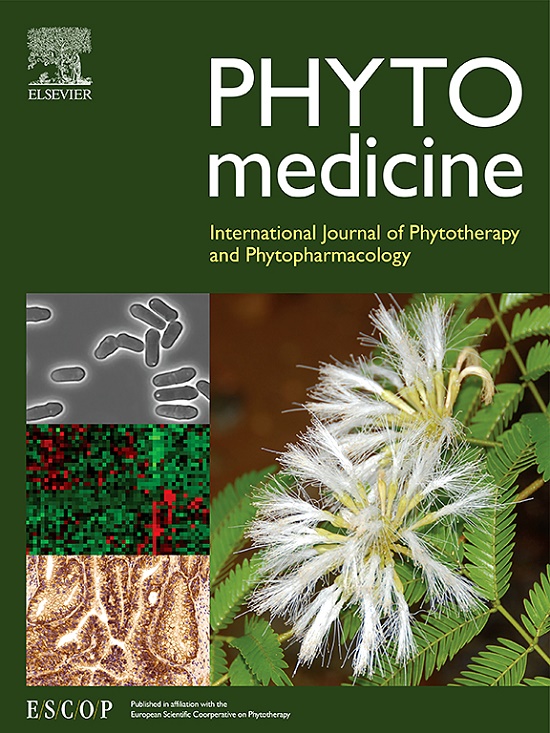Multi-omics and network pharmacology approaches reveal Gui-Ling-Ji alleviates oligoasthenoteratozoospermia by regulating arachidonic acid pathway
IF 6.7
1区 医学
Q1 CHEMISTRY, MEDICINAL
引用次数: 0
Abstract
Background
Gui-Ling-Ji (GLJ) described in the ancient medical book 'Yunji Qijian' is a traditional Chinese medicine formula used to improve male fertility. It is now available for the treatment of oligoasthenoteratozoospermia (OAT). However, the active ingredients and mechanism of GLJ are not clear.
Purpose
The aim of this study was to clarify the active ingredients and mechanism of GLJ in OAT.
Methods
Firstly, the cyclophosphamide-induced OAT rat model was established to evaluate the efficacy of GLJ. Secondly, serum/urine-based metabolomics and lipidomics and tissue-based transcriptomics were performed to discover the differential metabolites and genes in rats. Furthermore, network pharmacology was constructed to explore the associated mechanisms based on the results of multi-omics analysis. Finally, cellular experiment on testicular mesenchymal stromal cells (TM3) was used to validate the active ingredients and the key metabolic pathway.
Results
Rats were administered GLJ by gavage every day for 3 weeks. Testicular damage and weight loss caused by cyclophosphamide were restored in rats, the sperm count and motility were improved, and levels of luteinizing hormone (LH), follicle-stimulating hormone (FSH) and testosterone (T) secretion were also elevated. Compared to the metabolites of OAT rats, 51 and 37 differential metabolites regulated by GLJ were identified from serum and urine respectively, 54 lipid differential metabolites regulated by GLJ were identified by lipidomics. At the same time, 23 of the 258 differential genes were found to be regulated by OAT rats and then reverse-regulated by GLJ. Network pharmacology has identified 13 pathways (Steroid hormone biosynthesis, Taurine and hypotaurine metabolism, Primary bile acid biosynthesis, Linoleic acid metabolism, Retinol metabolism, Glycerophospholipid metabolism, Ether lipid metabolism, Sphingolipid metabolism, Arachidonic acid metabolism, Glutathione metabolism, Arginine biosynthesis, Arginine and proline metabolism, D-Arginine and D-ornithine metabolism), four metabolites (arachidonic acid, oestrone sulphate, phosphatidylglycerol choline and sphingomyelin) and 15 targets (ABCB11, ALDH18A1, CCL3, CD244, CIITA, CYP2C8, DLL1, ITGA4, ESR1, AR, ABCB1, ABCC1, ALB, PLA2G1B and NOS2). GLJ, psoralen, isopsoralen, liquiritin, isoliquiritin, liquiritigenin, and ginsenoside Ro could significantly promote T secretion from TM3 cells. Additionally, arachidonic acid metabolism particularly the cyclooxygenase pathway, is closely related to the promotion of testosterone secretion by GLJ in TM3.
Conclusion
GLJ has a therapeutic efficacy in cyclophosphamide-induced OAT rats, which can modulate the disorders of lipid metabolism and amino acid metabolism. Arachidonic acid metabolism may be a key pathway, and six prototype compounds are potential key active ingredients for GLJ.
多组学和网络药理学方法揭示桂灵芝通过调节花生四烯酸途径缓解少精症。
背景介绍古医书《云笈七签》中记载的桂苓膏(GLJ)是一种用于提高男性生育能力的传统中药配方。它现在可用于治疗少精症(OAT)。目的:本研究旨在阐明 GLJ 在 OAT 中的有效成分和作用机制:方法:首先,建立环磷酰胺诱导的 OAT 大鼠模型,评估 GLJ 的疗效。方法:首先,建立环磷酰胺诱导的 OAT 大鼠模型,评估 GLJ 的疗效;其次,进行基于血清/尿液的代谢组学和脂质组学研究,以及基于组织的转录组学研究,以发现大鼠体内不同的代谢物和基因。此外,还根据多组学分析结果构建了网络药理学,以探索相关机制。最后,利用睾丸间充质基质细胞(TM3)进行细胞实验,验证其有效成分和关键代谢途径:结果:每天给大鼠灌胃 GLJ,连续 3 周。结果:大鼠每天灌胃 GLJ 3 周后,环磷酰胺引起的睾丸损伤和体重减轻得到恢复,精子数量和活力得到改善,黄体生成素(LH)、卵泡刺激素(FSH)和睾酮(T)分泌水平也有所提高。与 OAT 大鼠的代谢物相比,从血清和尿液中分别鉴定出 51 和 37 种受 GLJ 调节的差异代谢物,并通过脂质组学鉴定出 54 种受 GLJ 调节的脂质差异代谢物。同时,在 258 个差异基因中,有 23 个被 OAT 大鼠调控后又被 GLJ 反向调控。网络药理学确定了 13 条通路(类固醇激素生物合成、牛磺酸和低牛磺酸代谢、初级胆汁酸生物合成、亚油酸代谢、视黄醇代谢、甘油磷脂代谢、醚脂代谢、鞘氨醇脂代谢、花生四烯酸代谢、谷胱甘肽代谢、精氨酸生物合成、胰岛素代谢)、精氨酸生物合成、精氨酸和脯氨酸代谢、D-精氨酸和 D-鸟氨酸代谢)、四种代谢物(花生四烯酸、硫酸雌酮和 15 个靶点(ABCB11、ALDH18A1、CCL3、CD244、CIITA、CYP2C8、DLL1、ITGA4、ESR1、AR、ABCB1、ABCC1、ALB、PLA2G1B 和 NOS2)。GLJ、补骨脂素、异补骨脂素、枸杞子苷、异枸杞子苷、枸杞子苷元和人参皂苷 Ro 能显著促进 TM3 细胞的 T 分泌。此外,花生四烯酸代谢,特别是环氧化酶途径,与 GLJ 促进 TM3 细胞睾酮分泌密切相关:结论:GLJ对环磷酰胺诱导的OAT大鼠有治疗作用,能调节脂质代谢和氨基酸代谢紊乱。花生四烯酸代谢可能是一个关键途径,而六个原型化合物是 GLJ 的潜在关键活性成分。
本文章由计算机程序翻译,如有差异,请以英文原文为准。
求助全文
约1分钟内获得全文
求助全文
来源期刊

Phytomedicine
医学-药学
CiteScore
10.30
自引率
5.10%
发文量
670
审稿时长
91 days
期刊介绍:
Phytomedicine is a therapy-oriented journal that publishes innovative studies on the efficacy, safety, quality, and mechanisms of action of specified plant extracts, phytopharmaceuticals, and their isolated constituents. This includes clinical, pharmacological, pharmacokinetic, and toxicological studies of herbal medicinal products, preparations, and purified compounds with defined and consistent quality, ensuring reproducible pharmacological activity. Founded in 1994, Phytomedicine aims to focus and stimulate research in this field and establish internationally accepted scientific standards for pharmacological studies, proof of clinical efficacy, and safety of phytomedicines.
 求助内容:
求助内容: 应助结果提醒方式:
应助结果提醒方式:


